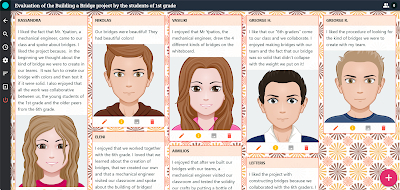First activities for the students
The first and sixth graders watched the two videos and spoke about what inspired them in the classroom. A discussion was held regarding the properties of bridges, their construction methods, materials, forms, applications, etc. A mind map was made based on the suggestions made by the pupils.
Benefits of the activities:
The activity of watching videos and engaging in discussions about bridges was a highly enriching experience for both first and sixth graders. Here, we delve into the added value of such an activity and the myriad benefits it brings to students.
Firstly, utilizing videos as a teaching tool allows students to visually comprehend complex concepts. Bridges, with their intricate designs and engineering marvels, can be better understood when seen in action. By watching videos showcasing different types of bridges, students can observe firsthand how various construction methods, materials, and forms come together to create these architectural wonders. Visual aids like videos stimulate curiosity and enhance retention, making the learning process more effective and enjoyable.
Furthermore, engaging in discussions following the videos encourages critical thinking and active participation. When students are prompted to reflect on what they've watched and share their thoughts, they are encouraged to articulate their ideas and perspectives. For first graders, this activity fosters language development and communication skills as they express their thoughts and listen to others. Meanwhile, sixth graders can deepen their understanding by analyzing and synthesizing information, honing their ability to think critically and logically.
The topic of bridges offers a rich interdisciplinary learning opportunity. Beyond engineering and construction, discussions can touch upon scientific principles like physics and mathematics. Students can explore concepts such as load-bearing structures, forces, and geometric shapes, thus integrating various subject areas into a cohesive learning experience. Additionally, bridges hold cultural and historical significance worldwide, providing avenues for exploring social studies and geography. By contextualizing the engineering marvels within broader cultural and historical contexts, students gain a deeper appreciation for the interconnectedness of knowledge.
Creating a mind map based on students' suggestions serves multiple purposes. Firstly, it reinforces the learning process by visually organizing and connecting key concepts discussed during the activity. Mind mapping encourages students to synthesize information and identify relationships between different ideas, promoting higher-order thinking skills. Additionally, the collaborative nature of creating a mind map fosters teamwork and peer learning. Students work together to brainstorm ideas, negotiate differences, and collectively construct a comprehensive representation of their understanding.
Moreover, the activity cultivates creativity and innovation. As students explore the various aspects of bridges, they are encouraged to think outside the box and envision new possibilities. Whether imagining futuristic bridge designs or brainstorming alternative construction materials, students are empowered to unleash their creativity and explore innovative solutions. This nurtures an entrepreneurial mindset and prepares students to tackle real-world challenges with ingenuity and resourcefulness.
Beyond academic enrichment, the activity promotes social and emotional development. Engaging in group discussions and collaborative activities fosters a sense of belonging and community within the classroom. Students learn to respect diverse perspectives, communicate effectively, and collaborate towards common goals. Furthermore, exploring topics like bridges can inspire awe and wonder, igniting a passion for learning and discovery.
In conclusion, the activity of watching videos, engaging in discussions, and creating a mind map about bridges offers multifaceted benefits for students. From enhancing academic understanding to fostering critical thinking, creativity, and social-emotional skills, this activity enriches the learning experience and empowers students to become lifelong learners and innovators. By leveraging the power of experiential learning and interdisciplinary exploration, educators can inspire the next generation of engineers, architects, and problem solvers.





Comments
Post a Comment